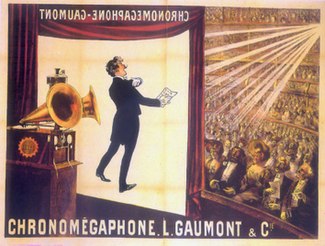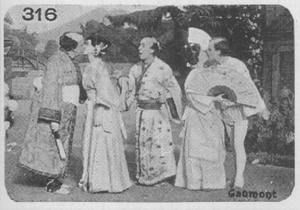Phonoscène
The Phonoscène was an antecedent of music video[1] and was regarded by Michel Chion, Noël Burch[2] and Richard Abel as a forerunner of sound film. The first Phonoscènes were presented by Léon Gaumont in 1902 in France. The first official presentation in the United Kingdom took place at Buckingham Palace in 1907.[3] The last phonoscène was presented in 1917.

History
The Phonoscène was a forerunner of sound film. It combined a chronophone sound recording with a chronograph film shot with actors lip-synching to the sound recording. The recording and film were synchronized by a mechanism patented by Léon Gaumont in 1902. The first Phonoscènes were presented by Gaumont in 1902 in France.[3]
Introduction in London

Phonoscènes were presented at Buckingham Palace on 4 April 1907 before Alexandra of Denmark, the Dowager Empress of Russia, the Prince and Princess of Wales and their children, The Princess Victoria, The Hon. Charlotte Knollys, General Sir Dighton Probyn, V.C., Mdlle. Ozeroff, The Hon. Sidney Greville (Royal Household of the United Kingdom), Colonel Blocklehurst and Colonel Frederick.[3][4] The "singing pictures", as the British press called them, were projected on a screen over a bank of palms.[5] The programme was a selection of phonoscènes previously presented at the London Hippodrome,[6] as follows:[3][7]
- The Miserere scene from Il Trovatore,
- The Captain's song and chorus from H.M.S. Pinafore,
- Tit-Willow from The Mikado,
- This little Girl and That, a song and dance from The Little Michus, and
- The Serenade from Charles Gounod's opera Faust.
Belle Époque
The three major french Belle Époque celebrities, Félix Mayol, Dranem and Polin were recorded by Alice Guy-Blaché using the Chronophone Sound-on-disc system to make phonoscènes.[8]
Last phonoscène to be projected and heard
J'ai du Cinéma was the last presented phonoscène at the Gaumont Palace ("Greatest Cinema Theatre of the world") on 29 June 1917.[9]
Notes
- Keazor, Henry and Wübbena, Thorsten (eds). "Introduction" to Rewind, Play, Fast Forward: The Past, Present and Future of the Music Video, transcript Verlag (2010) ISBN 978-3-8376-1185-4
- Burch, Noël. La Lucarne de l’infini. Naissance du langage cinématographique Paris, Nathan, 1991, chapter 10, p. 226, 5th footnote (quotation: "en puissance, le premier long métrage «parlant» !" ("in power, the first feature "talking" film !") English version: Life to those shadows University of California Press, Berkeley, BFI Londres, 1990
- Schmitt, Thomas. The Genealogy of Clip Culture, in Henry Keazor and Thorsten Wübbena (eds.) Rewind, Play, Fast Forward: The Past, Present and Future of the Music Video, transcript Verlag (2010), pp. 45 et seq., ISBN 978-3-8376-1185-4
- Daily Telegraph, London 5 April 1907, compiled by Gaumont press services conserved at the Bibliothèque du film in Paris (quotation: An afternoon entertainment of "Singing Pictures" at Buckingham Palace afforded much enjoyment. The Queen's command was received at the Hippodrome yesterday morning, instructing a private exhibition ... to be given in the Palace, commencing at three o'clock. ...[T]he instrument, placed in the [throne room], cast the pictures through the folding-doors [into the Green Drawing Room] upon a screen hung behind a bank of palms.
- Daily Mail, 5 April 1907 (quotation: ...the Queen showed her pleasure by commanding the putting on of extra pictures after the ordinary programme had been completed. The entertainment lasted about an hour.
- Altman, Rick Silent Film Sound, Columbia University Press (2005), p. 159, ISBN 978-0-231-11662-6 (quotation: Interest in synchronized sound systems was renewed in early 1907 with reports of the Chronophone's successful performance at the London Hippodrome.
- Daily Chronicle London, 5 April 1907
- Altman, Rick Silent Film Sound, Columbia University Press (2005), p. 158, ISBN 978-0-231-11662-6 (quotation: Films called Phono-Scènes were provided by ongoing in-house production overseen by Alice Guy, who directed the images after the sound-on-disk portion had been prerecorded by others.
- Schmitt, Thomas, « Scènes primitives. Notes sur quelques genres comiques “hérités“ du café-concert », in 1895 : revue de l’Association française de recherche sur l’histoire du cinéma (AFRHC),#61, 2010, p. 174. (text to be fully online on september 2013)